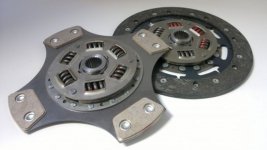Cheers,
I've been reading a lot of positive reviews of lightened flywheels for our barchettas.
From -14% to -20% less weight, after machining and balancing (Very important)
the original FIAT cast iron flywheel.
The driving experience changes a bit from what I heard, as the car goes more
freely up the rev range. As soon as the flywheel is properly balanced there aren't
really downsides relating to engine wear.
I would like to obtain feedack about experiences on this subject if possible.
Best regards.
I've been reading a lot of positive reviews of lightened flywheels for our barchettas.
From -14% to -20% less weight, after machining and balancing (Very important)
the original FIAT cast iron flywheel.
The driving experience changes a bit from what I heard, as the car goes more
freely up the rev range. As soon as the flywheel is properly balanced there aren't
really downsides relating to engine wear.
I would like to obtain feedack about experiences on this subject if possible.
Best regards.


